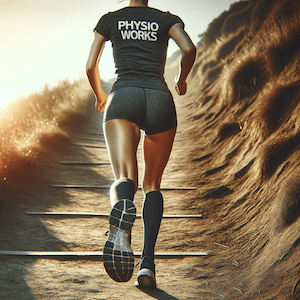3 Tips To Improve Your Running Efficiency!
Article by Erin Hickey
Three Tips To Improve Your Running Efficiency!
Running is an excellent way to keep fit while getting some fresh air. Altering your running technique in a few simple ways can vastly improve your efficiency, helping you to run for longer, as well as avoid any nasty overuse injuries.

1. Cadence Is Key!
The most common mistake runners make is over striding. This is when the foot reaches too far in front of the body during the swing phase, slamming your foot into the ground and producing a braking force which has to be negated by pulling your foot quickly back under your body, if pace is to be maintained. This is highly inefficient and also increases the pressure on your joints.
Increasing your cadence (steps per minute) will usually reduce over striding. Aiming for a cadence of 180 is a good rule of thumb, however your optimal cadence will depend on your biomechanics and height.
2. Avoid Heel Striking!
Avoiding over striding means nothing if you’re landing on your heels, as you’re still producing unnecessary braking forces. Aim to make initial contact with the ground either flat footed or with the forefoot.
3. Lean Forward, But Not From The Hips!
Combining the above points, you’ll find that your feet are making contact with ground further under/behind you than previously. You will want to lean forward, and you should, but ensure this is an entire body lean and not from your hips. A good cue is to tuck your bottom in.
Beyond these simple tips, your physiotherapist is trained to detect a broad range of movement abnormalities which may be holding you back or causing you pain. These may arise from knee and ankle positioning during running, isolated muscle weakness or range of motion deficits.
For an individualised assessment, contact your Physiotherapist.
Related Articles
- Running Injuries – Discover common running injuries and how to prevent them. This article directly relates to improving running efficiency and preventing overuse injuries.
- Heel Pain & Plantar Fasciitis – Learn about causes and treatment options for heel pain, which is often relevant for runners, especially those struggling with heel striking.
- Runners Knee Pain – Gain insights into various types of knee pain, its causes, and treatments. Since the article mentions knee positioning during running, this link is highly relevant.
- Ankle Injuries – Explore information on preventing and treating ankle injuries, a common concern for runners, especially in the context of foot positioning and cadence.
- Leg Pain – Understand the causes of leg pain and how physiotherapy can help, given that running efficiency heavily involves the legs.
- Sports Physiotherapy – Find out how sports physiotherapy can enhance performance and assist in injury recovery, directly appealing to runners looking to improve efficiency.
- Biomechanical Analysis – Learn about how a biomechanical analysis can improve your running technique and efficiency, directly tying into the article’s focus on biomechanics and height affecting cadence.
- Stretching Exercises – Discover stretching exercises that can improve flexibility and performance in running, potentially improving efficiency and reducing the risk of injuries.
- Strength Training for Runners – Understand the importance of strength training in improving running performance and efficiency, especially in preventing isolated muscle weakness mentioned in the article.
- Gait Analysis – Read about how gait analysis can identify movement abnormalities and improve running efficiency, directly relevant to the article’s mention of detecting movement abnormalities for better running performance.



